16 September 2025
Key takeaways:
- The global share market1 rose for the fifth consecutive month.
- US shares gained 2.0%, closing at an all-time record high a day before month end.
- European markets added 1.0%, with the UK driving gains and France underperforming amid political instability.
- Australasian equities benefited from interest rate cuts, with strong small-cap performance and declining bond yields supporting both equity and fixed interest markets.
Below is an in-depth review of financial markets over August.
Global equity markets extended their winning streak in August, notching a fifth consecutive month of gains in USD terms. This was despite an uncertain backdrop that included political and geopolitical turbulence, central bank uncertainty and shifting investor sentiment.
In the US, the share market2 rose 2.0% (all returns are in local currency unless otherwise stated) for the month. The index closed at a record high on 28 August before paring back some of those gains on the last trading day of the month. Positive investor sentiment aided the gains, focusing on the possibility of interest rate cuts from the US Federal Reserve. Sector performance was broadly positive, led by materials and healthcare, with the latter rebounding strongly after a weak July. Utilities was the only sector to decline in the US.
The European share market3 posted a 1.0% gain, extending its quarterly advance. The UK was the biggest contributor to European performance, while France lagged amid renewed political instability. Sector-wise, healthcare and consumer staples led, with returns above 4% and 3%, respectively, while information technology, utilities and industrials all posted modest declines of 1.7%.
Closer to home, August was a constructive month for Australasian investors, with central bank action providing a tailwind. Both the Reserve Bank of Australia and the Reserve Bank of New Zealand cut their benchmark interest rates by 0.25%, supporting shares and lifting fixed income markets. Australian shares4 rose 3.1%, closing just shy of the 9,000 mark, while the New Zealand share market5 gained slightly under 1%. Small-cap stocks outperformed across both markets, with the S&P/NZX SmallCap Index jumping over 7.3%, and Australia’s S&P/ASX Small Ordinaries rising 8.4%.
In New Zealand, reporting season offered a chance to reassess company fundamentals after a period of economic and geopolitical headwinds. The next 12 months is shaping up as a transitional year for many companies, and investors will be watching the AGM season closely for signs of earlier than expected recovery in trading conditions.
With the focus on central banks cutting or anticipated to cut interest rates, fixed interest yields generally declined over August. US 2-year Treasury yields fell 0.35% to 3.59%, while the 10-year yield eased 0.12% to 4.24%. It was a similar story in New Zealand, with the 2-year Government Bond dropping to 2.99%, while the 10-year finished at 4.39%.
The differing fortunes of various market indices are illustrated in the chart below.

Note: Returns are in local currency terms.
The outlook
A resilient global economy has allowed financial markets to withstand the barrage of headlines and elevated policy uncertainty this year. Our lead investment manager’s (JBWere) base case is that this continues, allowing global equity markets to continue to push higher.
The most important driver of equity market performance over the long run is corporate profitability. Indeed, superior profit growth is the key reason why the US equity market has been able to meaningfully outperform its developed world peers over the majority of the past decade or so. As corporate profitability is heavily dependent on underlying economic conditions, JBWere’s primary focus right now, as it often is, is whether we need to be preparing for a sustained period of economic weakness or even recession, in the US and global economies.
Reflecting disruptions from tariffs, heightened uncertainty more generally and an extended period of restrictive monetary policy, it’s clear that the US economy has cooled. Job creation has softened, and the unemployment rate is creeping higher. However, JBWere does not believe a recession or even extended period of subdued US activity is the most likely outcome. Private sector balance sheets are strong, the US Federal Reserve has ample room to begin cutting interest rates again, the build-out of AI infrastructure and supporting activity is massive, and fiscal policy is likely to turn modestly stimulatory again next year. While JBWere is mindful of the risks from geopolitics and elevated policy uncertainty, they believe the medium-term picture for the US and global economies is generally still a healthy one, which should allow markets to continue to look through any near-term tariff-related disruption.
Already this year has had plenty of twists and turns, but JBWere’s approach to portfolio management has not changed. Elevated uncertainty and obvious catalysts for further market volatility just reinforce the need to maintain good investment and portfolio construction discipline. This is the focus within the MAS Schemes, where our active management style allows us to regularly test and adjust conviction levels when deemed necessary. The economic and market landscape is constantly evolving. But through strong diversification and its exposures to high-quality investments, we believe the MAS Schemes are well positioned to weather what could be in store next.
We have useful online tools to help you:
- Our Fund Finder can help you see if you're in the right Fund for your circumstances.
- Our KiwiSaver Retirement Calculator can help you understand if your retirement savings are on track.
- Our MAS Investor Portal can help you manage your investments online.
If you decide to change your Fund after reviewing your risk profile or meeting with a MAS Adviser, you can make a switch via the MAS Investor Portal, or alternatively you can complete an investment strategy change request form. There is no fee for switching. Links to the relevant forms are below.
- MAS KiwiSaver Scheme: KiwiSaver Documents and Forms – MAS
- MAS Retirement Savings Scheme: Retirement Savings Scheme Documents and Forms – MAS
- MAS Investment Funds: Investment Funds Documentations and Forms
You can see weekly updates on fund unit prices and returns on our website.
1 As represented by the MSCI All Country World Index.
2 As represented by the S&P 500 Index.
3 As represented by the Euro Stoxx 600 Index.
4 As represented by the S&P/ASX 200 Index.
5 As represented by the S&P/NZX 50 Index.
This article is of a general nature and is not a substitute for professional and individually tailored advice. Medical Funds Management Limited, JBWere (NZ) Pty Ltd and Nikko Asset Management New Zealand Limited, their parent companies and associated entities do not guarantee the return of capital or the performance of investment funds. Returns indicated may bear no relation to future performance. The value of investments will fluctuate as the values of underlying assets rise or fall.
MAS is a financial advice provider. Our financial advice disclosure statement is available by visiting mas.co.nz or by calling 0800 800 627.
The Product Disclosure Statement for the MAS KiwiSaver Scheme is available: KiwiSaver – MAS
The Product Disclosure Statement for the MAS Retirement Savings Scheme is available: Retirement Savings Scheme – MAS
The Product Disclosure Statement for the MAS Investment Funds is available: Investment Funds – MAS
Medical Funds Management Limited is the issuer and manager of the Schemes.
